PFAS Contamination in 8 Communities From Nearby Incinerators
RSS
Analies Dyjak, M.A. | Head of Policy and Perspectives
“Forever Chemicals” or PFAS are a category of contaminants that are found in drinking water supplies across the country. PFAS are associated with the production of both chemical and consumer products - most notably, it’s use in firefighting foam or AFFF. Military installments engage in on-base training activities that require the use of PFAS-containing firefighting foam. The Department of Defense (DoD) has granted approval for 8 facilities across the country to burn PFAS chemicals. Many of these communities did not have problems with PFAS contamination prior to contracts with DoD.
What Are The Health and Environmental Impacts Associated With Exposure to PFAS?
PFAS are known to cause cancer, increase the risk of miscarriage, increase cholesterol, and cause various other health impacts. Drinking water accounts for up to 75% of PFAS exposure, but can be problematic through inhalation. PFAS typically enter drinking water directly from facilities that manufacture PFAS-containing products. New research has found that PFAS do not fully break down when incinerated, and may indirectly enter drinking water that way as well. There are also growing concerns about PFAS accumulation in fish, which could cause an additional route of exposure for humans. There are currently no EPA approved testing methods for PFAS in ambient air.
8 Facilities Approved To Burn PFAS In The United States
There are 8 incinerators approved by the Department of Defense to burn PFAS chemicals. Not all of the locations are actively burning PFAS, or have burned PFAS in the past:
- East Liverpool, Ohio
- Grafton, Ohio
- Port Arthus, Texas
- Deer Park, Texas
- Sauget, Illinois
- El Dorado, Arkansas
- Arkadelphia, Arkansas
- Cohoes, New York
Why Are We Burning PFAS In The First Place?
There is no scientific consensus on how to entirely remove PFAS from the environment. The Department of Defense even acknowledged that “no satisfactory disposal method has been identified” and that “many likely byproducts will be environmentally unsatisfactory.” This is in part due to the fact that PFAS were created not to break down in the environment. The carbon-fluorine bond is the strongest carbon bond there is.
Incineration Facility in Cohoes, New York
The approved incineration site in Cohoes, New York, resulted in significant environmental damages. The Norlite incineration facility burned PFAS chemicals for over a year without the residents’ approval. The Norlite facility was granted a contract from the Department of Defense to burn PFAS chemicals from military bases across the country. A team of researchers from Bennington College detected PFAS downwind of the plant - indicating that the PFAS were not fully incinerated. The town of Cohoes and bordering municipalities did not have a PFAS problem until these chemicals were brought from out of state. On November 23, 2020, the Governor of New York signed legislation that bans the incineration of PFAS chemicals in certain cities, including Cohoes.
What Does This Mean For You and Your Family?
If you live near a PFAS incineration facility, it’s important to remain informed. Because PFAS are unregulated by the federal government, most actionable changes are being made by advocacy groups, and state and local governments. You can always use our Water Nerds as a resource for any questions you might have regarding PFAS contamination in your area. If you are looking to purchase a water filter, you’ll want to make sure that it’s able to remove PFAS. Hydroviv filters were part of a Duke University and NC State PFAS removal study that determined the effectiveness of residential water filters and their ability to remove PFAS. Hydroviv filters were effective at removing PFAS at the 1 and 6 month mark, while other major filtration brands were not.
Other Articles We Think You Might Enjoy:Do TDS/ppm Meters Provide Meaningful Information About My Water Quality?
How To Tell If Your Home Has Lead Pipes or Plumbing
5 Things You Need To Know About Chromium 6 In Drinking Water




